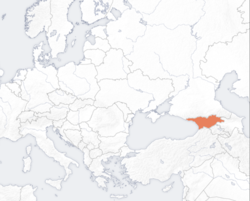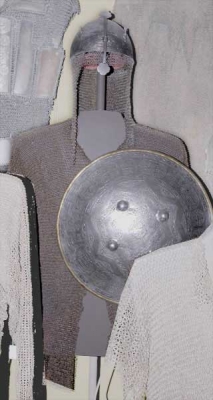Mail, helmet, and shield (1911.29.1)
 GeorgiaMail, helmet and shield from Georgia, Europe. Thought to have been collected by Percy Manning. Given to the Museum in 1911.
GeorgiaMail, helmet and shield from Georgia, Europe. Thought to have been collected by Percy Manning. Given to the Museum in 1911.
This is a set of armour from Tbilisi, the capital of Georgia in the Caucasus, Russia; where Europe meets Asia. The helmet is a variant of the Indian 'top' called a missiourka - a shallow dome with a long mail 'aventail' to protect the neck, a sliding nasal and two plume holders at the temples.
Mail armour and shields such as this were actively worn and used until the 1870s in the Caucasus (often juxtaposed with more modern firearms), representing one of the last survivals of chain mail in the world.
The Art of War
Tbilisi has been a regional centre of arms production for centuries, and was home to communities of armourers from Georgia, Armenia, Dagestan and Ossetia. The Caucasus was a cultural crossroads between the Ottoman Turks to the West, the Safavid Persians to the east, and the Russians to the north. All three of these major powers struggled for control of the Caucasus (and the nearby Crimea) between 1770 and 1864, before the Russians asserted control. In 1918, Georgia, Armenia and Azerbaijan proclaimed their independence. This chequered history means that Caucasian art displays a range of influences.
Since Georgia is an ancient stronghold of Christianity, Muslim Dagestanis, Armenians or Azerbaijanis probably produced this Islamic-style armour. Dagestan, in particular, was subject to endemic warfare, and so Dagestani men constantly wore armour. One particular Dagestani group called themselves Kubatchi (in Tartar) or Zirh-Geran (in Farsi), meaning 'The Mail-Makers', and exported their work considerable distances. This armour shows clear Persian influences such as little brass hooks used to close the collar and a shield of distinctively Persian form and decoration. The incised pattern on its surface comprise a concentric star-shaped arabesque, cartouches, floral compositions and Persian inscriptions in Arabic script. Since intricate arabesques are also a distinctive Dagestani characteristic, this is further evidence that this armour is of Dagestani origin.





